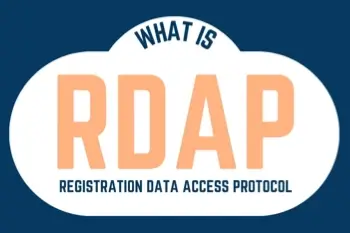What Is RDAP (Registration Data Access Protocol)?
We all use websites daily, but few realize the protocols that keep the Internet's domain system organized. One crucial protocol that works behind the scenes is Registration Data Access Protocol. If you’ve ever needed information on a website's owner or IP address, you’ve likely encountered RDAP. In this article, learn what RDAP is, how it works, and how it's implemented.
What is RDAP?
Registration Data Access Protocol (RDAP) is a standard protocol for accessing domain name registration data. The IEFT standardized RDAP in 2015 to enable users to view current information for top-level domains (TLDs).
It replaces WHOIS, a protocol for looking up information about Internet resources. Every registrar is contractually required to implement Registration Data Access Protocol, as outlined in their agreements with ICANN, the governing body that oversees the DNS system.
RDAP offers a more structured method for retrieving information about domain names and IP addresses. At its core, it enhances how we access the data behind websites, Internet service providers, and IP addresses.
The new protocol addressed the shortcomings of the aging WHOIS system. The former failed to meet modern demands for security, privacy, and internationalization. As the Internet grew, the limitations of WHOIS became more apparent.
Registration Data Access Protocol is a more scalable protocol. It supports features that improve data retrieval and, most importantly, safeguard user privacy while ensuring that necessary information is still accessible.
History of Registration Data Access Protocol
The development of RDAP was a direct response to WHOIS's limitations. WHOIS was introduced in the 1980s when the Internet was much smaller. The need for structured data, security, and privacy wasn’t as critical then.
WHOIS simply allowed anyone to look up information about domain names. This openness became a problem with the rise of data privacy laws.

By the early 2000s, the flaws of WHOIS were undeniable. Its plaintext format was difficult for machines to read and parse. There was also no native support for non-English characters, making it harder to query information about domain names in languages other than English.
Another critical issue was the lack of security, as WHOIS queries were sent over unencrypted connections. This practice exposed sensitive information to potential interception.
In 2011, the Internet Corporation for Assigned Names and Numbers (ICANN) recognized the need for a replacement and initiated the development of RDAP. The Internet Engineering Task Force (IETF) soon took over the technical side of this development.
By 2015, ICANN formally introduced RDAP through a series of Request for Comments (RFC) documents, including RFC 7480–7485. These documents laid out the technical standards for RDAP.
WHOIS was gradually phased out as Internet service providers adopted RDAP. While Registration Data Access Protocol is not yet universally used, its adoption is growing steadily. Organizations that manage large databases of internet-related information were among the first to implement RDAP.
How Registration Data Access Protocol works
RDAP operates using the HTTP protocol, which is similar to how websites work. When you query using RDAP, the server returns data in a machine-readable format. Registration Data Access Protocol organizes data in JSON format for straightforward interpretation.
For instance, rather than presenting all the information in a single block of text, RDAP organizes data into fields such as domain name, IP address, registrant, and contact details. This format enables software developers to build applications that can more effectively automatically query this information.
Security is RDAP's major focus. All communication between the client and server can be secured using HTTPS to encrypt the transmitted data. This prevents unauthorized third parties from intercepting sensitive information during the query process.
The RDAP protocol supports role-based access control, which means that different types of users can access other levels of information based on their credentials. For example, a government agency investigating a cybercrime may need to access more detailed information than an ordinary user. RDAP can be configured to provide that distinction.
Registration Data Access Protocol allows for more complex queries. Users can search for domains, IP addresses, and organizations using filters such as country, registration date, or even specific keywords.
Benefits of Registration Data Access Protocol
RDAP brings numerous benefits that were insufficient in WHOIS.
Structured data format
One of the primary strengths of RDAP is its use of JSON to format data. With WHOIS, the data was scattered and hard to work with. RDAP’s JSON format organizes the information in a way that is both human-readable and easy for computers to process.
Enhanced privacy and security
RDAP addresses a significant flaw: security. All data exchanges happen over HTTPS, so sensitive information stays encrypted. The data protocol prevents unauthorized users from intercepting the information during queries. For users, it adds a layer of confidence that their registration information remains protected from cyber threats.
Advanced search capabilities for domains and IP data
Another thing is that it offers a much more powerful search feature. You can filter domains using parameters like keywords, regions, or registration dates. You find exactly what you’re looking for without sifting through irrelevant results.
Support for internationalized domain names (IDNs) and non-ASCII characters
The support for internationalized domain names is a game changer. RDAP allows domain name information to be displayed in non-ASCII characters.
Role-based access control
It allows registries to limit the amount of information accessible to different users. Not every user needs the same level of access to data, so RDAP adjusts based on who is making the request. For example, a law enforcement agency might need full access to registration data, while a regular user would only get basic public information.
RDAP vs. WHOIS
When comparing RDAP and WHOIS, it's important to understand how they differ. Both are computer network communications protocols. They serve the same basic function - retrieving registration data - but they differ in how they accomplish this task.
The most obvious difference is in the data format. WHOIS delivers data in a flat text format. This makes it impossible to automate without custom parsing tools. RDAP, on the other hand, provides data in a manner that both humans and machines can process.
Another key difference is security. WHOIS lacks a built-in security measures, and all queries and responses travel over unencrypted connections. Registration Data Access Protocol solves this by using HTTPS for all communications.
WHOIS offers all users the same level of access, regardless of their credentials. This often led to abuse, with cybercriminals using WHOIS data to target domain owners. Registration Data Access Protocol introduces role-based access control to allow registries to limit the amount of information each user can access.
In terms of query functionality, Registration Data Access Protocol also offers more advanced search capabilities. While WHOIS only allows users to search for domains directly, RDAP supports more complex queries.
Implementing RDAP
Implementing Registration Data Access Protocol requires significant changes to the infrastructure of registries that previously relied on WHOIS. The first step is upgrading the server infrastructure to handle RDAP queries.
This involves configuring servers to respond to HTTP and HTTPS requests and to deliver data in JSON format. Most registries will also need to implement role-based access controls to ensure that sensitive information is only accessible to authorized users.
Legal compliance is another important consideration. Different countries have different regulations regarding the privacy and handling of personal data. For instance, the European Union’s General Data Protection Regulation (GDPR) places strict limits on how groups can collect personal data.
Registries that deploy the protocol must configure their systems to comply with these regulations. It protects sensitive data and simultaneously provides access to authorized users.
While implementing Registration Data Access Protocol can be resource-intensive, the long-term benefits make it worthwhile. Registries that adopt RDAP provide scalable access to registration data.
Applications of Registration Data Access Protocol
There are several common use cases for Registration Domain Access Protocol.
- Domain management. Domain name registries use RDAP to provide access to information about domain ownership, registration dates, and contact details. This information is essential for managing domain names, especially for organizations that own large numbers of domains.
- IP address registries. They use RDAP to manage IP address allocations. These registries provide information about who owns specific blocks of IP addresses, which is important for network operators, Internet service providers (ISPs), and law enforcement agencies. By using RDAP, these organizations can access this data in a structured, secure, and efficient way.
- Cybercrime investigators. Investigators benefit from RDAP’s advanced search capabilities. When investigating cyberattacks, it’s often necessary to trace the ownership of domain names involved in the attack. RDAP allows investigators to access this information securely, reducing the risk of exposing sensitive data during the investigation.
- Researchers and academics. They use RDAP to study trends in domain registration and IP address allocation. By querying registration data, they can gain insights into how the Internet is evolving, how domains are used, and who controls key Internet infrastructure. The structured data format of RDAP makes it easier to analyze large datasets and draw meaningful conclusions.
Challenges and the future of RDAP
Despite its many advantages, the adoption of Registration Data Access Protocol has been slow. One limitation is the complexity of implementation.
Many smaller registries lack the resources to upgrade their infrastructure to support RDAP. Some stakeholders, particularly those accustomed to using WHOIS, still lack awareness about RDAP.
Another challenge is balancing privacy and transparency. RDAP offers more advanced privacy controls than WHOIS, but it still faces challenges in complying with diverse privacy regulations worldwide.
Registries must ensure they provide enough data to meet legal requirements and user needs while protecting sensitive information from misuse.
However, as more organizations adopt it, Registration Data Access Protocol will continue evolving to meet the Internet's changing needs. The IETF is actively working on updates to the RDAP standard to address its current limitations and improve its functionality.
In the long term, RDAP could become the de facto standard for accessing registration data, replacing WHOIS entirely.
Frequently asked questions
Who manages Registration Data Access Protocol?
Registration Data Access Protocol is developed by the Internet Engineering Task Force (IETF) and overseen by domain registries and regional Internet registries (RIRs).
What kind of data can RDAP access?
Registration Data Access Protocol can access a sort of RDAP database of domain names, IP addresses, and autonomous system numbers, along with their registration and contact details.
What is differentiated access in RDAP?
Differentiated access allows different levels of information visibility based on the requester's identity, role, or purpose.
What are RDAP extensions?
Registration Data Access Protocol allows custom extensions for registries to provide additional data fields or services beyond standard Registration Data Access Protocol functionalities.

